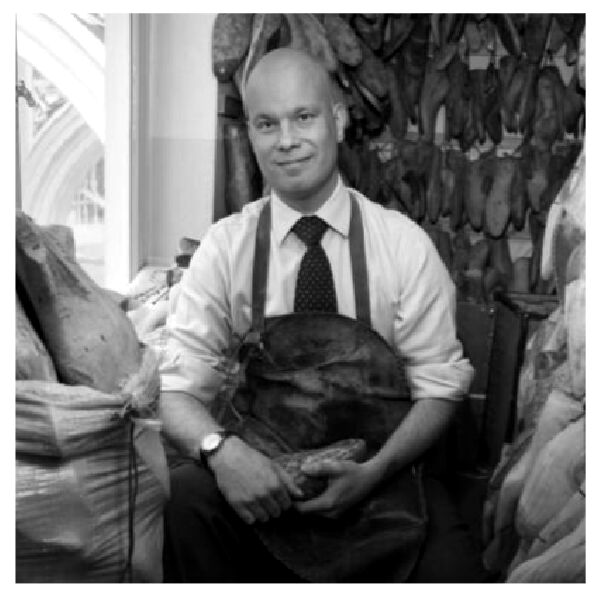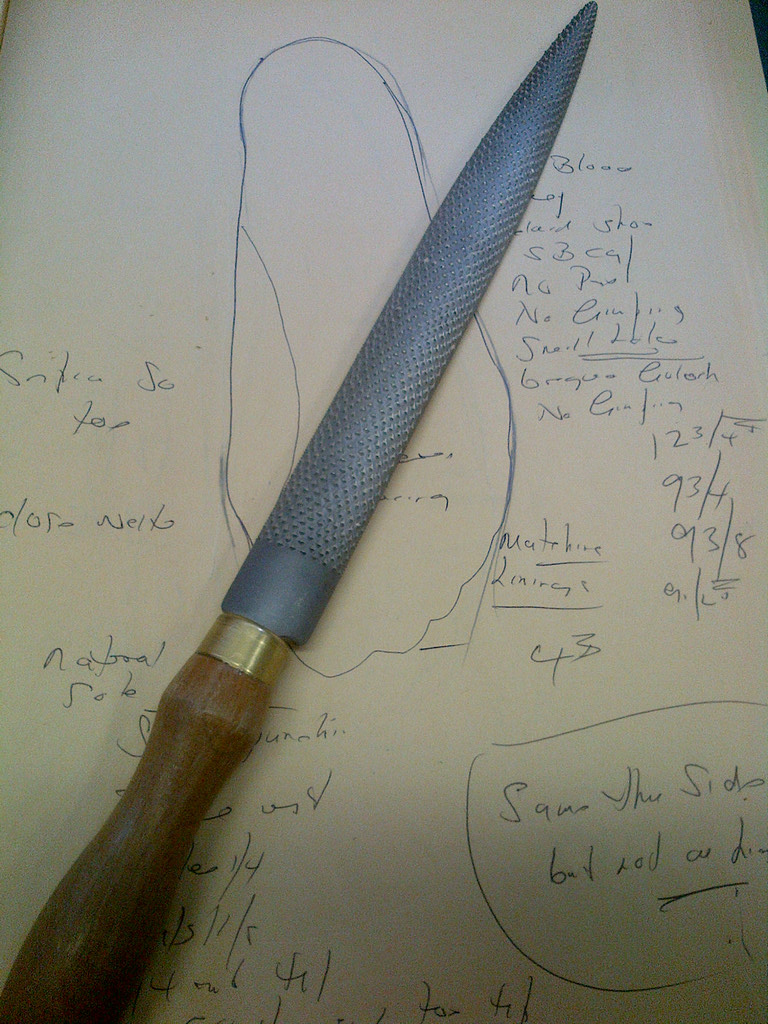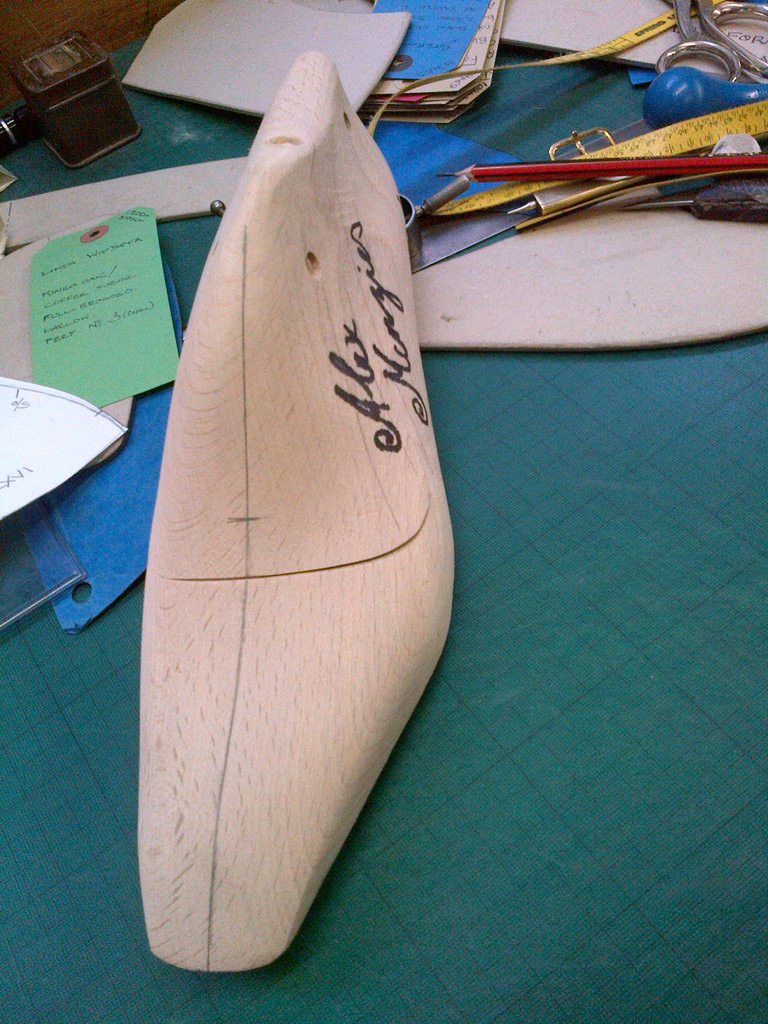Interview with Teemu-Pekka Leppänen
0April 20, 2013 by Ville Raivio
‘I’m just about to turn 38. In this business, age generally helps. Somehow you get a little bit more respect, the older you seem to be. We call this “Grey hair syndrome”. I guess it must be because in the trade each and every bit of skill in the respective part of shoemaking is painstakingly achieved, and honed over years and years. No matter how many years you may have under your belt, everyday one can still learn something new. I’ve been The Workshop Manager at G.J. Cleverley’s for over 10 years now.
Products from Pukimo Raivio
Ralph Lauren, Black Label suit, size 52EU
I started being interested in shoes from a very young age. My mother tells me, that “kenkä”, the finnish word for shoe, was the first word that I learned to say. Also, in primary school I was refused to take up textile design as a subject over woodwork, because my mother was the teacher in the class, and she didn’t want to teach her own son. That, and general interest in working with your hands, made me choose to study Special techniques in handiworks, in which my major was shoemaking, from “Kuopion käsi-ja taideteollisuus akatemia”. This was a BA course for 3 years, after which I wanted to further my studies with an intensive course in shoemaking and repairing in Kankaanpää, Finland.
The end of the course was always going to be integral part of the training, because it was the work experience section. In my mind, I always had only a handful of options, because I was always more interested in the actual making side of shoemaking rather than design. England, and particularly London, has an amazing heritage for bespoke shoemaking. Also, it was an obvious choice because a beautiful girl I was going out with was doing her work experience in London at the same time.
As soon as I had started my work experience job, it became very clear to me how much there was to learn about the whole of the shoemaking process. I became convinced that any type of learning that one does in a shoemaking college of any sort only provides a mere base for all future learning. After my 3-month-long work experience period of tea making, polishing, shoeroom finishing and the occasional glimpse of shoemaking, I got very interested in the trade.
I was delighted to hear that my current employer at the time was also very happy with my progress, and did offer a contract for me. After some thought I was happy to accept the offer and start up my life all again in a new country. It proved to be a very good place to hone my skills and meet lots of similar-minded individuals. I started out in the shoeroom, finishing, taking off (pulling the last out of) and socking (inserting the interior of shoes) all the finished shoes, and soon got more interested in bottom making. Learned a great deal of bottom making under a very experienced guidance, and finally got more and more interested in last making. Mainly by the poor standard of last making that was in place, that meant lots of more unnecessary work for the bottom makers.
Towards the end of my tenancy I had acquired a good set of skills in last making, and practically jumped at the chance, when I heard that The Best Shoemakers In The World were looking for a new last maker. I got a slot in an interview and somehow my five years’ experience in the trade was enough to pull the result towards my way. It was a good foundation, but still it opened up my eyes to how vast the learning curve is to learn just one area of the shoemaking. The great reward in shoemaking is the fact that, after each day of hard work, one can hold the day’s creation in their hands and admire the results. You get to meet lots of very interesting people from all different walks of life. It gives me great pleasure to occasionally spot the shoes, that I was part of making, in a catwalk, cinema or even just on the street.
In English shoemaking, the four different shoemaking principles are divided into four separate specialist fields: Last maker, as you can imagine, will measure the customer and make their last (a wooden replica of the client’s feet). The pattern maker and Clicker will make the paper pattern to the design chosen, and cut the desired pieces in the material chosen by the client. The closer will stitch together the pieces of leather to form the upper part of the shoe. The bottom maker will last (pull over) the leather upper over the last, and stitch the upper onto the leather insole by hand. To master any one of these four principles would last 5 to 10 years. That, I feel, is the secret of the exquisite skills of English shoemaking.
I do hope my children will learn to like the art of crafts as well. My son, Eelis, 5, has already taken his first steps towards it by re-subscribing for his school’s sewing club for the third time. And my daughter Emmi, 7, has excelled in several different areas of crafts at home and school. I met my wife in the college, we were on the same course for three years, so naturally we’ve a fairly good understanding about each others’ work. She does bookbinding and leather interiors, so even if the objects are different, the main theme still remains the same. Even the local magazine for this area in South London did an interview of our family at the end of last year.
Travelling is big part of the trade, because not everybody will be able to come and see you in the shop. Therefore, each year, before we start to travel, I’ll try to make sure that there would be at least two or three new designs on the show. Therefore, it’s very difficult to pick just one shoe that would my favourite. It think it does evolve all the time, when new designs are being drafted. But one of my all-time favourite designs is the old George Cleverley’s Elastic-sided shoes with a brogued cap. An incredibly simple design that delivers on the functional level. Excellent travelling shoe, very comfortable casual shoe that provides support for all day because of the side elastics.
Cleverley’s does carry on the legacy of the traditional english bespoke shoemaking that started hundreds of years ago. George Cleverley was a shoemaker in the third generation, therefore the traditions are very deep within the company. Which makes it a great honour to be working for them. The fit of the shoes is always the first priority, combined with the elegance of handmade shapes and designs. There is an old saying within the trade: “People in the know go to Cleverleys: people who don’t, go elsewhere”.
Because of my young family, I don’t get a chance, nor that I would want it either, to have much time to do anything else apart from shoemaking and my family. Therefore I do try to use my commuting time for myself, that’s why I try to cycle to work whenever I’m not taking the children to school. I’m also a member of the local cycling club and occasionally join them for a weekend ride. Hopefully one day my family may share this passion as well!
When I was in the college I used to wear size 7.5 shoes. When I started my journey into shoemaking, and sizing, and all the rest of it, I ended up wearing size 10. And I’m now much more comfortable for it. I’d never wear the same shoes twice in the same week. It’s important to let the shoes breathe. In the same token, all shoes will need to be worn every now and then. If you were to leave a pair of shoes sit in the cupboard for too long, they will dry up and start creaking and, at worst, the leather can crack. I’ll always keep the shoetrees inside the shoes when not wearing them, this absorbs the moisture from inside the shoe and keep their shape. Also important is to polish the shoes regularly with a wax-based polish, that will also nourish the leather. ‘
Pictures: © Teemu-Pekka Leppänen
Category Cordwainers, Interviews | Tags:







Leave a Reply